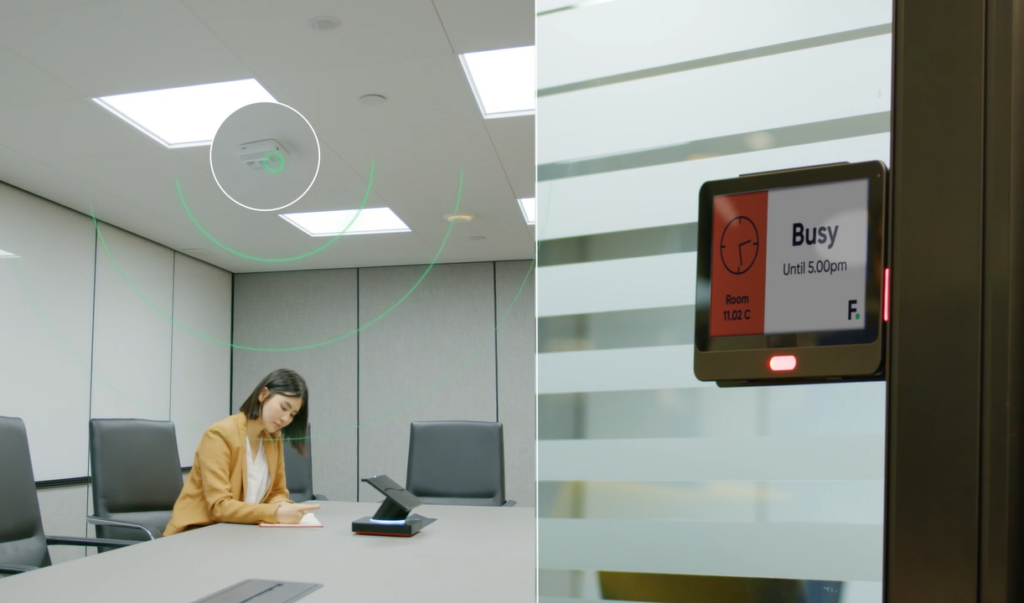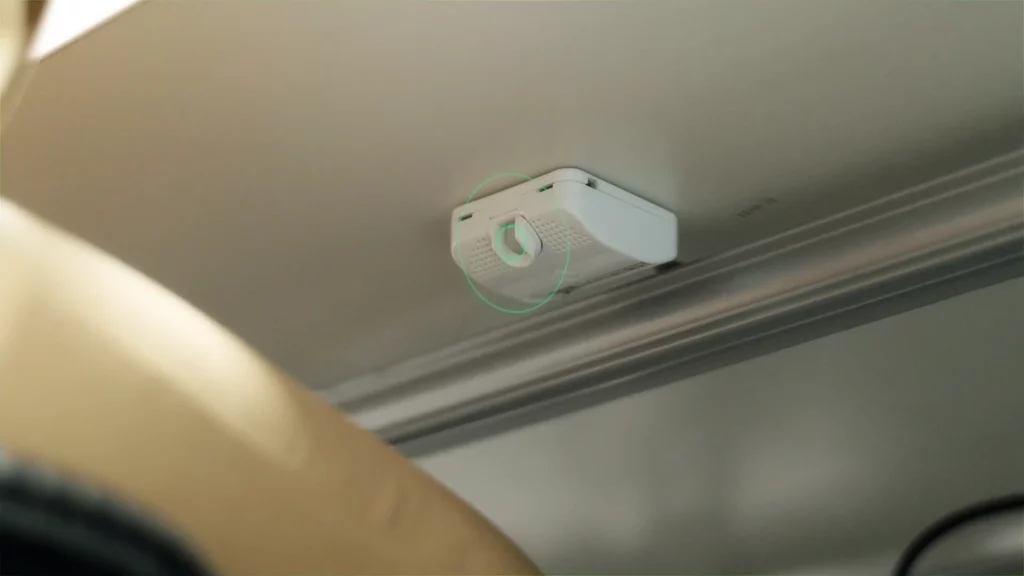

The need to measure utilisation and automate the office environment has resulted in a significant move towards the use of occupancy sensors in recent years, and for good reason. There are significant benefits of using occupancy sensors such as:
- Creating data-driven workplace designs.
- Optimising real estate based on occupancy.
- Using occupancy to automate utility usage.
- Helping users quickly locate available space.
- Helping users navigate the space and use it effectively.
These sensors are now a fundamental part of performance-oriented workplaces. Since there are a variety of options available for the technology used in sensing occupancy, it’s worth understanding the two major options.

Sensor options
When it comes to sensing technology for the workplace, there are two main approaches used: camera-based sensors or non-optical sensors. While camera-based sensors work on the principle of capturing an image of the objects in their field of view, non-optical sensors operate on capturing other parameters such as a thermal image, time of flight detection, doppler footprint, or an ultrasonic reflection.
In most cases, sensors are complemented using a PIR-type sensor that would initiate measurement based on presence. This is no different from intrusion detection sensors that alarm human movement.
In this blog post, we will explore the advantages and disadvantages of both types of sensors. Starting with the factors to consider when deciding between camera-based vs non-optical sensing options:
- Privacy
Camera-based optical sensors, which capture images or footage, are commonly associated with security monitoring. This correlation has sparked conversations around privacy in the workplace; resulting in a negative experience caused by feelings of unease due to the knowledge of being monitored. Typically, these optical sensors use lower-resolution cameras than those used for security monitoring and therefore result in low-resolution images. In several cases, some level of Artificial Intelligence is utilised to analyse an object’s image in real-time to detect what it is and match that against the signature image of a human. It’s this data that’s then submitted and assessed; not the live video footage itself. The danger here lies with the video feed, if accessed before submitting its task, confidential information will be exposed. In many cases, vendors provide sufficient checks and protections to ensure that personally identifiable information (PII) is not transmitted by the devices. However, there is no denying that this information is necessary in order to count the image as a human being. As the cost of cloud computing has decreased there are an increasing number of vendors proposing to securely transmit the entire video stream to the cloud and analyse for human patterns remotely. This does carry the risk of compromising PII information.
Non-optical sensors by design do not possess the capability to capture PII data. Utilising sensors such as thermal imagers can provide the same level of data without appearing invasive or risking confidential organisational information. This is achieved by simply detecting only the heat signatures of a person as they move or enter certain spaces with no need for intrusive visuals. The key challenge associated with delivering success with these sensors is the ability to extract the signal of human presence from the surrounding noise of all other thermal noise of the background. When this technology is mastered, it can give a unique sense of human and environmental activity. Thermal sensors can also pick up excursion conditions with HVAC such as overheating or over cooling. It can pick up signatures of devices that generate heat when used and don’t switch off when no one is present, helping target energy wastage. Since thermal sensors differentiate humans based on the temperature difference of the body from the surroundings, they are not suitable for outside spaces. Other technologies may be more suitable here including time of flight or radar (doppler) sensors which can offer similar outcomes.
- Performance
Optical sensors have the upper hand in providing high-quality imagery. The level of data quality is great to see exactly who, where, and how a person moves objects that are visible in the field of view, and in some cases even details of documents on tables and desks. Some of this data can be useful to understand human activity; however, there is always the question of how data is prevented from being compromised.
Non-optical sensors can provide the level of accuracy needed to do the job of counting people, using an appropriate level of image resolution to differentiate human beings. By capturing repeated frames of thermal images, it is possible to ‘see’ how the target has moved through the monitored spaces to provide that same level of granularity within the analysis, all without the need for capturing imagery that identifies individual characteristics. Non-optical sensors also have the advantage of not relying on the ambient lighting conditions in the area being monitored, are not affected by reflected images or pictures of humans on walls and they typically consume less energy compared to other types of sensors.
- Ease of Installation
Non-optical sensors are often simpler to set up than their optical counterparts. One of the main advantages is their relatively low power consumption allowing them to be operated using batteries where necessary. This is a huge advantage when it comes to deploying sensors rapidly to gain a preliminary understanding of occupancy. Additionally, their generally smaller and lightweight design makes it possible to mount them on walls or ceilings using adhesive pads, while their low power and low data needs enable them to establish a connection with a wireless network. As a result, extensive wiring is not necessary.
In contrast, optical sensors may require more extensive cabling and infrastructure to install. In some instances, due to power and data processing needs these sensors are POE (Power Over Ethernet) only and not available for wireless deployments. Cameras are typically heavier and may also require additional infrastructure like mounting brackets, protective housings, and lighting. Additionally, if such infrastructure is needed, one may require the services of a professional installer, which can add to the overall installation cost.
- Unit Cost and Cost of Privacy
The cost of sensors is governed by the features they typically possess. Sensors that have peripheral intelligence to process data to result in the count and position of people typically need more local processing power. This increases the unit cost of the sensors but reduces the cost of transmitting and processing data in the cloud. The cost of electronics associated with any type of sensor (optical or non-optical) is broadly the same – a sensing chip, pre-processors, CPU, transmitter chip, power management, etc.
However, the overall cost of ownership is less dependent on individual chip costs, it is significantly more affected by how many vendors are involved in the delivery of insights from data. Using multiple vendors at scale and their management across geographies can add more than 50% to the total cost of the project and in some instances the complete failure of the project. The argument about the unit costs of sensors becomes moot at this point. Optical sensors have the further risk that they may violate the laws (or in some cases just overcome privacy concerns) of workers in different geographies. It may become quite expensive for an organisation to discover that they are unable to switch a capability on after installation because the local team could not be convinced that it is safe to use these sensors.
- Detecting Passive Occupancy
Occupancy can be determined in two ways, active or passive, the latter is where an individual isn’t using a desk or meeting room, but they have left their belongings in the space. Active is where there is an active presence which makes for clear identification of occupancy. According to a recent CBRE study, approximately 50% of space in the workplace is passively occupied. For instance, if your data may show a current passive occupancy of 1000 desks out of 5000, it is likely missing another 1000 desks. This would be down to a space not currently being utilised by an active human presence.
Detecting passive occupancy not only requires higher resolution of imaging, but it also comes with the challenges of missing dilemmas (i.e., incorrect detection), risk of confidential data capture, and heavy cost of computation. In any case, the question does arise how does one use such data? While it is of course ok to leave your bag and walk away from your desk for a few hours in a day, what is unacceptable is to use the desk for everything other than working from it.
Optical sensors claim to utilise AI to detect passive occupancy by looking for items placed on a desk and classing them as occupied. The inaccuracies of this method come from the nature of how people use a workplace desk in the age of a ‘Clean Desk Policy’. Where bags and items may be placed in lockers or under a desk, the optical sensor is unable to detect these scenarios.
The solution comes by enforcing policies on the data, where a person can have a set absence time threshold before the space classes the user as ‘absent’. Same for presence, we may want to ensure the user is at the desk for a set time before we class them as present, this is imperative when obtaining accurate analysis of workplace utilisation.

Making the Right Choice for Your Organisation
When it comes to choosing between optical and non-optical sensors for your organisation, it’s important to consider the specific needs and requirements of your business.
Optical Sensors – Advantages
- High-resolution imaging: Optical sensors, such as cameras, provide high-resolution images that allow for more detailed analysis and monitoring of workspace occupancy.
- Wide area of coverage: Linking to the high resolution, a wider lens can be installed to cover a wider area. Requiring for less devices and installations.
- Real-time monitoring: Optical sensors can offer real-time monitoring, allowing businesses to respond quickly to changing occupancy conditions, such as overcrowding or underutilisation of spaces.
Optical Sensors – Disadvantages
- Privacy concerns: The use of cameras for presence detection may raise privacy concerns among employees & employers alike, particularly in sensitive areas such as break rooms where individuals may expect a higher level of privacy. In addition to privacy concerns, the use of cameras may also pose a risk to the confidentiality of (PII) data.
- Performance in low-light conditions: Optical sensors rely on light for image capture, which can result in poor performance in low-light environments or areas with frequent lighting changes. Optical sensors may also double-count reflections on smooth surfaces such as meeting tables.
- Installation complexity: As optical sensors are more power-hungry and network intensive, the installation will require more work and cabling for the client. Increasing costs and maintenance throughout the deployment.
Non-Optical Sensors – Advantages:
Enhanced privacy protection: Non-optical sensors, such as PIR or thermal imaging, do not capture images, ensuring a higher level of privacy for employees while still providing accurate presence detection.
Consistent performance in varying light conditions: Non-optical sensors are not dependent on light, ensuring consistent performance in both well-lit and low-light environments.
Lower energy consumption: Non-optical sensors generally consume less power than optical sensors, helping businesses reduce their energy consumption and overall operational costs.
Complete Wireless Capability: With the sensors requiring less power, they can be powered completely by battery. Along with being connected wirelessly to the network, making for a very simple installation process.
Non-Optical Sensors – Disadvantages:
- Lower Resolution Capture: Non-optical sensors provide presence data without visual context, though thermal imaging modules provide this via heat signatures, the resolution is generally less than that of an optical sensor.
- Number of devices: Due to the lower resolution, more devices may be required to cover larger areas. This is due to the lens FOV (Field Of View) that thermal modules are capable of handling.
Final Thoughts.
Ultimately, the perfect occupancy monitoring solution is one that is specifically tailored to a company’s individual needs. When it comes down to deciding between camera-based sensors and non-optical sensors, the privacy requirements and installation needs of a workspace largely determine which option would be best suited. Choosing the right solution depends on individual needs well as any constraints of the workspace environment.
Non-optical sensors are an ideal solution for those looking to minimise the risk of personal data leakage as well as maintain accurate occupancy levels but with a less bulky setup. Alternatively, optical sensors offer the benefit of covering wider areas and thus require fewer devices – so long as there is minimal workspace variation in relatively open-plan spaces. However, with more complex floor plans this approach may lead to reduced effectiveness.
With the right sensor, trends can be identified and informed decisions can be made about the office layout. It comes down to finding the right balance between security, cost, and convenience that best suits your organisation’s needs in order to make an informed decision about which type of sensor will work best for your workplace.
Freespace isn’t your average sensor solutions provider; we’re pioneers in workspace management. Our proprietary, privacy-focused sensor technology is customised for each workspace’s needs, outperforming one-size-fits-all solutions. We empower you with data layering for understanding complex associations, leading to thoughtful decision-making. It’s not just about occupancy metrics but gaining operational insights. Take the opportunity now to transform your workspace into an efficient and motivating environment. Schedule a demo with us today.


